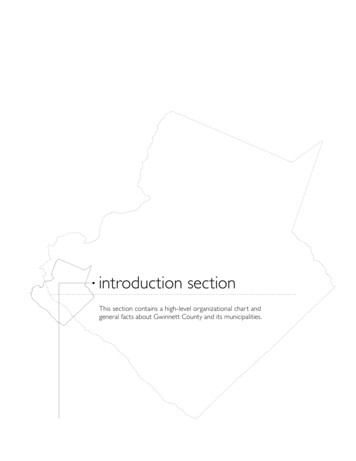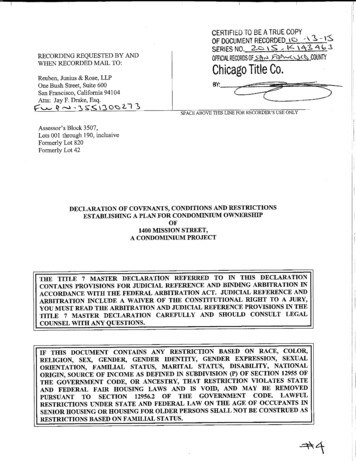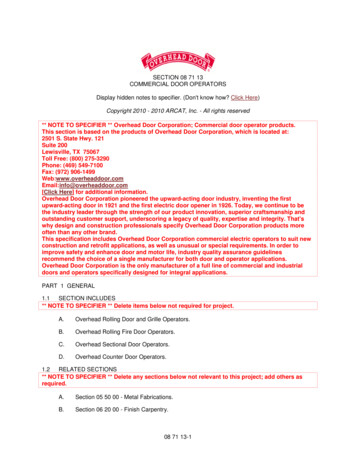
Transcription
introduction sectionThis section contains a high-level organizational chart andgeneral facts about Gwinnett County and its municipalities.
2012Budget DocumentgwinnettcountyGwinnett County Organizational ChartGwinnett County CitizensBoard of CommissionersOther Elected OfficialsSheriffTax CommissionerJudicial SystemCourtsOther Boardsand AuthoritiesProsecuting OfficesClerks of CourtLaw DepartmentCounty AdministratorPerformance AnalysisCFO/DeputyCounty AdministratorDeputy CountyAdministratorFinanceCommunity ServicesCommunicationsHuman ResourcesCorrectionsCounty ClerkInformationTechnology ServicesPlanning andDevelopmentFire andEmergency ServicesSupport ServicesTransportationPolice ServicesWater ResourcesFY 2012 Budget Document gwinnettcountyI 1
gwinnettcounty2012Budget DocumentCounty Administration/Department DirectorsCounty AdministratorGlenn P. StephensHuman ResourcesKenneth Poe, DirectorDeputy County Administrator/CFOAaron J. BovosInformation Technology ServicesJohn Matelski, DirectorDeputy County AdministratorVacantPlanning and DevelopmentBryan Lackey, Acting DirectorCounty AttorneyM. Van Stephens, Acting County AttorneyPolice ServicesChief Charles M. WaltersCommunity ServicesPhil Hoskins, DirectorSupport ServicesVacantCorrectionsWarden David PeekTransportationKim Conroy, Acting DirectorFinancial ServicesMaria Woods, DirectorWater ResourcesLynn Smarr, Acting DirectorFire and Emergency ServicesChief Bill MyersElected OfficialsState Court JudgesRobert W. Mock Sr., Chief JudgePamela D. SouthJoseph C. IannazzoneCarla E. BrownRandolph G. RichJohn F. Doran Jr.Clerk of CourtRichard T. Alexander Jr.District AttorneyDaniel J. PorterChief Magistrate Court JudgeGeorge F. Hutchinson IIIProbate Court JudgeWalter J. Clarke, IISheriffR.L. “Butch” ConwaySolicitorRosanna SzaboTax CommissionerRichard SteeleJudicially Appointed OfficialsJuvenile Court JudgesRobert V. Rodatus, Chief JudgeStephen E. FranzénRobert WallerSuperior Court JudgesK. Dawson Jackson, Chief JudgeMichael C. ClarkMelodie Snell-ConnerDebra K. TurnerWilliam M. Ray IIR. Timothy HamilRonnie K. BatchelorThomas N. Davis Jr.Warren P. DavisKaren E. BeyersHomer M. Stark, Senior JudgeClerk of Recorder’s CourtJeff C. WestCourt AdministratorPhilip M. BoudewynsRecorder’s Court JudgesMichael Greene, Chief JudgeRodney S. HarrisPatti MuiseI 2FY 2012 Budget Document gwinnettcounty
2012Budget DocumentgwinnettcountyGovernment Finance Officers Association StatementThe Government Finance Officers Association of the United States and Canada (GFOA)presented an award of Distinguished Budget Presentation to Gwinnett County, Georgiafor its annual budget for the fiscal year beginning January 1, 2011.*In order to receive this award, a governmental unit must publish a budget document thatmeets program criteria as a policy document, as an operations guide, as a financial plan,and as communications device.The award is valid for a period of one year only. We believe our current budget continuesto conform to program requirements, and we are submitting it to GFOA to determineits eligibility for another award.* This award is the highest form of recognition in governmental budgeting. Gwinnett County hasreceived this prestigious award for 23 years.FY 2012 Budget Document gwinnettcountyI 3
gwinnettcounty2012Budget DocumentHistoryCovering 437 square miles of frontier land the Creek and Cherokee Indians ceded tothe state, Gwinnett County was named after Button Gwinnett, one of Georgia’s threesigners of the Declaration of Independence. The Georgia Legislature created GwinnettCounty on December 15, 1818.In 1819, the home of Elisha Winn, one of Gwinnett’s early leaders instrumental in thecreation of the county and in whose parlor the early planning took place, becamethe first county courthouse. The first elections were held in the parlor, and superiorcourt proceedings were conducted in his barn, while the first jail stood nearby. Winnselected Lawrenceville as the site for the county seat and donated the land for thefirst permanent courthouse, which was completed in 1824 for 4,000. When it wasdestroyed by fire in 1871, a second courthouse was constructed in 1872, but was torndown in 1884 when it was deemed inadequate. It was finally replaced in 1885 with thebuilding now known as the Historic Courthouse and was used as the county’s courthouse until 1988, when the construction on the Gwinnett Justice and AdministrationCenter was completed.In 1914, a portion of Gwinnett was joined with parts of Walton and Jackson Counties toform Barrow County. More of Gwinnett’s land area was lost in the mid-1950s with theconstruction of Buford Dam. As the Chattahoochee River was backed up behind thenew dam, the water of Lake Lanier covered hundreds of acres.PopulationAccording to the most recent Census number, in 2011 Gwinnett’s population was estimated at 822,467. Based on projections, Gwinnett is expected to reach nearly onemillion by the year 2026.Public SafetyThe Department of Corrections operates the Comprehensive Correctional Complex,an 800-bed prison facility that contains 512 beds for state and county inmates classifiedas minimum or medium security. This complex also contains 288 work release beds fornon-violent criminal offenders sentenced to part-time incarceration and parents whohabitually fail to pay court-ordered child support. The correctional complex is the onlygovernment-owned prison in Georgia that is nationally accredited.Gwinnett County’s Department of Police Services is a nationally accredited agencywith an authorized strength of 758 sworn officers, supported by 307 non-sworn employees providing law enforcement services to the county. The department’s goals in2012 are to continue to meet the needs of the increasing population and its changingdemographics, and to ensure fiscal responsibility while providing the latest technology,facilities, training, and equipment.Gwinnett County’s Department of Fire and Emergency Services covers one of the largest demographic areas in the state of Georgia. Serving this area with fire protectionand emergency medical services is the mission of the department. The departmentmeets its challenge with an authorized force of 844 well-trained men and women. FireI 4FY 2012 Budget Document gwinnettcounty
2012Budget Documentgwinnettcountystations are strategically located to provide quick response times for fire, medical, andother emergencies. In fall 2010, Fire Station 18 was relocated to Hamilton Mill; new firestations 29 and 30 opened in Buford and Loganville, respectively.TransportationGwinnett County’s infrastructure includes more than 2,750 miles of roads, which includemore than 675 signalized intersections. The 2012 Capital Budget and 2012 – 2017 planfor the Transportation Capital Improvement Program (CIP) totals over 199 million.Construction continues on the Sugarloaf Parkway Extension from SR 20/GraysonHighway to SR 316/University Parkway, east of Lawrenceville. Construction of SectionTwo (New Hope Road to Martins Chapel Road) was completed and opened to trafficon December 14, 2010. Construction on Section Three A (Martins Chapel Road toCampbell Road) was opened to traffic on August 18, 2011. Construction on SectionThree B (Campbell Road to SR 316/University Parkway) began in January of 2011 and isanticipated to be opened to traffic in late 2012.Briscoe Field is the fourth busiest airport in the state, located on approximately 500acres. It is capable of handling all light, general aviation and most corporate jet aircraft.Two fixed base operators provide excellent service and three flight schools provideinstruction.Gwinnett County Transit operates local bus service Monday through Saturday. Sixtythree Express Buses operate weekdays during peak travel times. The six express routesallow individuals to park their cars at central locations and take transit to destinationsin downtown and midtown Atlanta. In 2011, the Transit system transported more than2.2 million people on express and local buses.EducationGwinnett County Public Schools is the largest school system in Georgia and continuesto grow. Total enrollment for 2011 – 2012 was approximately 161,000 including studentsin 77 elementary schools, 26 middle schools, 19 high schools, and 11 other educationalfacilities. The average cost to educate a student is 7,638 per year. Gwinnett’s schoolsystem serves over 180,000 meals daily and operates over 1,800 school buses that travel more than 24 million miles annually. An average of 120,662 students are transportedtwice daily. In fiscal year 2012, the total budget is 1.70 billion dollars.Gwinnett County Public Schools was the recipient of the 2010 Broad Prize through theEli and Edythe Broad Foundation. As the winner of the largest education award in thecountry, Gwinnett County Public Schools will receive 1 million in college scholarshipsfor its high school students. This annual award honors large urban school districts thatdemonstrate the strongest student achievement and improvement while narrowingachievement gaps between income and ethnic groups. The money goes directly tograduating high school seniors for college scholarships.There are 40 private schools in Gwinnett, and the City of Buford operates its ownpublic school system.FY 2012 Budget Document gwinnettcountyI 5
gwinnettcounty2012Budget DocumentGwinnett is also home to several universities, such as DeVry Institute of Technology,Shorter College, Gwinnett Technical College, and Georgia Gwinnett College.Georgia Gwinnett College opened its doors as a four-year college in fall 2006. Prior tothat, the college only offered a two-year associate degree. The first Georgia GwinnettCollege graduation was held in June 2008. The new Student Center opened in January2011. As of spring semester 2012, there should be nearly 8,000 students.In May 2008, The University of Georgia moved its Gwinnett programs from the campusit shared with Georgia Gwinnett College to its new location near Sugarloaf Parkway andI-85, and changed its curriculum to graduate programs and continuing education only.Established in 1935, the Gwinnett County Library System has grown to 15 full-servicebranches. Construction of the most recent library branch, Hamilton Mill Branch Library,began in 2008 and opened in 2010. It was the County’s third “green” building. Afterreceiving the Building of America Gold Medal Feature, the library was recognized bythe Georgia chapter of the U.S. Green Building Council with an Honorable Mention forExcellence in Sustainability.Business EnvironmentGwinnett County has maintained its AAA rating from all three major credit rating agencies since 1997, and is one of only 36 counties in the United States with this rating. TheCounty’s favorable rating indicates solid financial management and results in significantinterest savings for our citizens.Gwinnett County issued 21,158 occupation tax certificates (business licenses) in 2011.Gwinnett’s hospitality and international sophistication, along with affordable real estate and a well-educated labor pool, continues to attract a comprehensive array ofdiverse companies.For nearly 30 years, Gwinnett has been a major retail center. It became home toGwinnett Place Mall in 1984, the Mall of Georgia in 1999, and Discover Mills in 2001. Inaddition to being a retail center, Gwinnett is also a high-tech hub.Gwinnett Chamber Economic Development globally markets Gwinnett as the premierlocation in metro Atlanta and the State of Georgia for growing and conducting business.By encouraging investment and trade into the county through relocation and expansionassistance, the organization works with local and regional partners to bring technology, communications, life science, advanced manufacturing, supply chain operations andcorporate headquarters to the community. During the past decade, Gwinnett Countyhas been a top job creator in Metro Atlanta, and has become home to FORTUNE 500and 1000 companies. From small businesses to industry giants, from global companies tohomegrown start-ups- it is clear, Success Lives Here in Gwinnett County.Gwinnett County caters to domestic and international businesses of all sizes and worksto promote the industries of: advanced communications, information technology, manufacturing/supply chain management, healthcare and life sciences, and corporate headquarters/professional services. Gwinnett’s assets in these related sectors are strongand efforts are targeted to: ensure companies continue to be satisfied with their Gwinnett location, expand their presence in Gwinnett County; and help grow additionallocal economic opportunities.I 6FY 2012 Budget Document gwinnettcounty
2012Budget DocumentgwinnettcountyThe vision is that Gwinnett will be known as an inclusive community where businessesthrive and residents maximize their potential through world-class schools, opportunities for life long learning, a vibrant economy, diverse partnerships, and a superior qualityof life.Recreation and ArtsThe Operations Division of Gwinnett Parks and Recreation offer award-winning parksand leisure activities year round to the young and young at heart citizens of GwinnettCounty. From a stroll on a trail, to playing a sport, to learning how to swim, to exploring the past and enjoying Gwinnett County history, to a fitness or pottery class, to ahorseback or bike ride; there is something for everyone. They also offer facility rentalsand partner with Gwinnett’s 27 volunteer youth athletic associations to offer sportssuch as baseball/softball, basketball, cheerleading, football, soccer, roller hockey, and thenewest sport lacrosse. In 2011 the division offered over 6,000 classes, summer camps,and special events.Gwinnett County Parks and Recreation operates 44 parks and facilities that include: 150sports fields, 51 tennis courts, 31 multi-purpose sports courts, two indoor and sevenoutdoor leisure pools, four indoor competition pools, three indoor instructional poolsand one outdoor pool, six dog park areas, six cultural/historic sites, over 100 miles oftrails, seven skate complexes, 52 playgrounds, picnic areas, pavilions, fishing lakes, andmore. In 2011 the George Pierce Park section of the Ivy Creek Greenway (1.25 miles)and Rhodes Jordan Park renovations (except for the soccer complex) opened, bothscenic additions to the County park system. Additional information regarding capitalprojects is found in Section VI.Gwinnett County continues to place a high priority on greenspace, as well as active andpassive park land. As of 2011, the total parkland acreage grew to 9,282 acres for bothpassive and active parks.The Gwinnett Center consists of a convention center, 702-seat performing arts center,13,000-seat arena, and a grand ballroom. Beautiful landscaping and on-site parking makea visit to any of these facilities enjoyable.A 50,000-square-foot exhibit hall anchors the Convention Center. This facility also has23 meeting rooms that can accommodate up to 1,000 attendees. The Grand Ballroomis also located in the Convention Center and is a spacious 21,600 square feet. The Arenacontinues to be home to the Gwinnett Gladiators of the East Coast Hockey Leagueand the Georgia Force of the Arena Football League. Included in the facility design are36 corporate suites, wider seats, high-end sound, and versatile lighting. This facility is apopular venue for family shows, sporting events, music concerts, and many other typesof entertainment. A parking deck was added to the facility in 2009 providing 950 spacesfor patrons.The Triple-A affiliate of the Atlanta Braves, the Gwinnett Braves, moved from Richmond,Virginia to Lawrenceville in 2008. Coolray Field is a state-of-the-art stadium seating morethan 10,000 fans, which opened in April 2009. The opening of Coolray Field has generated more than 400 jobs in the county. Since the opening of Coolray Field, the teamhas welcomed more than 1,112,000 fans and it is becoming an increasingly popularvenue. The Gwinnett Braves have given back to the community by donating more than 900,000 to local nonprofits. This amount includes monthly grants through the Atlanta Braves Foundation, ticket fundraisers, and auctions held at the stadium as well asFY 2012 Budget Document gwinnettcountyI 7
gwinnettcounty2012Budget Documentin-kind ticket and memorabilia donations, which have been provided to the community.In 2012, Coolray Field will host many events in addition to the 72 regular season Gwinnett Braves games, including the Atlanta Braves All-Stars vs. Future Stars ExhibitionGame and Gwinnett County Public Safety Day.HealthcareGwinnett Medical Center (GMC) is a 553-bed, not-for-profit healthcare network comprised of two hospitals, a nursing facility, and a full spectrum of outpatient services.The Hospital System employs more than 4,100 associates and approximately 800 affiliated physicians. GMC is comprised of the following licensed facilities: Gwinnett MedicalCenter in Lawrenceville with 353 acute care beds, Gwinnett Medical Center in Duluthwith 81 acute medical/surgical beds and 30 acute physical rehabilitation beds, and theGwinnett Extended Care Center on the Lawrenceville campus with 89 nursing homebeds. These facilities provide a continuum of inpatient and outpatient health care services, including general acute care, emergency services, physical rehabilitation services,skilled nursing services, along with diagnostic and ambulatory surgical services. Specialized services include a Level II Trauma Center, a Level III Neonatal Intensive Care Unitsupporting newborn care, a Chest Pain Center, the Center for Neuroscience, minimallyinvasive robotic surgery, and comprehensive Sports Medicine and Orthopedic Careservices. In 2010, GMC served over 400,000 patients (ER discharges, inpatient andoutpatient surgical patients, and outpatient visits).In September 2009, the new patient tower (North Tower) located on the Lawrenceville campus opened and added 129 acute beds to the system. It features the newlyopened 40,000-square-foot Strickland Heart Center for total cardiac care, from PCI(angioplasty and stenting) to open heart surgery to cardiac rehabilitation. The Duluthcampus is the first all-digital hospital in north Atlanta. It is also home to the state’s leading sports medicine program.Serving the area since 1980, the Emory Eastside Medical Center in Snellville is a 310-bedfull-service hospital, which includes a pediatric urgent care unit, day surgery, obstetrics,breast health center, and an in-patient physical rehabilitation center. The hospital hasover 450 physicians and employs 1,200 clinical and support staff. The Eastside HeritageCenter, located at the original hospital campus on Fountain Drive, specializes in the careand treatment of many adult conditions. The center includes programs for senior mentalhealth, wound care, sleep disorders, and pain management. Eastside Digital Imaging atLoganville is located on Highway 81 South and offers an array of imaging services.Gwinnett County Health and Human Services supports the needs of residents throughcoordination with private and public organizations. It participates in the planning of theGwinnett Coalition for Health and Human Services, provides services to Gwinnett’ssenior citizens, develops and manages one-stop service centers, and manages Countyfunding for nonprofit and other governmental organizations. Numerous health centersthroughout Gwinnett County offer medical care to residents who meet income andeligibility requirements.I 8FY 2012 Budget Document gwinnettcounty
2012Budget DocumentgwinnettcountyGovernmentBuilt in 1885 and renovated in 1992, the Historic Courthouse is located on the squarein downtown Lawrenceville and is open for tours Monday through Friday. Countyoffices were housed in this facility until 1988. This building serves as a public museum and meeting facility for citizens and civic organizations. The annual lighting of theChristmas tree at Thanksgiving, the Moonlight and Music Summer Concert Series, andmany other festivals are held here during the year.Governed by a five-member Board, Gwinnett’s local government is composed of achairperson elected at-large and four commissioners elected by district for four-yearterms. The chairperson appoints the County Administrator, who oversees 13 executive departments.While most county government operations are located in the Gwinnett Justice andAdministration Center (GJAC), some departments are now located in the AnnexBuilding, One Justice Square, and the Recorder’s/Juvenile Court facility. As relocationsand additions occur, the existing facilities undergo reconfigurations to better meetresidents’ needs.FY 2012 Budget Document gwinnettcountyI 9
gwinnettcounty2012Budget DocumentMunicipalitiesAuburn – Located on U.S. Highway 29 between Lawrenceville and Athens, Auburnbecame a part of Gwinnett County in 1988 annexing 2,500 acres.Rest HavenSugar eeCornersBerkeleyLakeDaculaLawrenceville85Berkeley Lake – Established in 1956, Berkeley Lake is located near the ChattahoocheeRiver and is mostly residential with wooded lots and rolling hills.Braselton – Settled in 1876, part of this municipality is located within Gwinnett whereproperty was annexed in 1989. It also extends into Barrow, Hall, and Jackson counties.Buford – Buford is Gwinnett’s northern most city with a small portion of the city inHall County. It was founded in 1872 and originally developed as a railroad town.NorcrossGraysonLilburnLoganvilleDacula – Founded in 1891, a branch of the Seaboard Coastline Railroad was constructed from Dacula through Lawrenceville to Duluth. Elisha Winn is one of Gwinnett’searly leaders and his home served as a temporary first courthouse.SnellvilleSpanning 437 square miles, Gwinnett Countyhas 16 municipalities within its boundaries.For 2011, there were an estimated 822,467people who called Gwinnett home.(Source – U.S. Census Loganville2,474*Norcross9,116Peachtree CornersRest HavenN/A**32*Snellville18,242Sugar Hill18,522Suwanee15,355Lilburn – In 1892 a railroad stop known as the town of McDaniel developed. Changingto Lilburn in the early 1900s, this city is named after Lilburn Trigg Myers who was thegeneral superintendent for the Seaboard Airline Railway.Loganville – This town also started as a branch of the railroad in 1898 and is anothercity that Gwinnett shares with an adjoining county.Norcross – The second oldest city in Gwinnett, Norcross was founded as a resorttown for wealthy Atlantans. Chartered in 1870, Norcross has an area of 112 acres listedin the U.S Register of Historic Places.Peachtree Corners – The Georgia General Assembly passed legislation on March 16,2011, to hold a referendum for voters to consider the incorporation of the City ofPeachtree Corners. The referendum passed on November 8, 2011.Rest Haven – Incorporated in 1940, Rest Haven is one of the newest cities in Gwinnettat only a mile and a half wide.Snellville – In 1885 Snellville was founded by Thomas Snell and James Sawyer. It islocated on U.S. Highway 78 in the southeastern corner of the county.651,695Sugar Hill – This town’s name came when a freight wagon traveling down a steep hill.In the 1800s, the wagon spilled its load of sugar all over that hill becoming “Sugar Hill.”The city was chartered in 1939.* Population within Gwinnett County** City was incorporated after Census datawas compiled.Suwanee – Beginning as an Indian village and later developed as a railroad stop,Suwanee was officially founded in 1837 with the establishment of the post office.UnincorporatedI209*Berkeley LakeGraysonGrayson – An area of rolling pastures and small farms, Grayson was founded in 1880.Previously known as Berkely, it is another city given birth by the railroad.Lawrenceville – Lawrenceville is the largest city in Gwinnett. Incorporated in 1821, it isthe second oldest city in metro Atlanta and is the county seat.POPULATIONApril 1, 2010AuburnDuluth – In the early 1800s, this town was part of Cherokee Indian territory. In 1821,it developed as the town of Howell Crossing and in 1873 the town name was changedto Duluth following completion of the railroad. 10FY 2012 Budget Document gwinnettcounty
Gwinnett is also home to several universities, such as DeVry Institute of Technology, Shorter College, Gwinnett Technical College, and Georgia Gwinnett College. Georgia Gwinnett College opened its doors as a four-year college in fall 2006. Prior to that, the college only offered a two-year associate degree. The first Georgia Gwinnett











